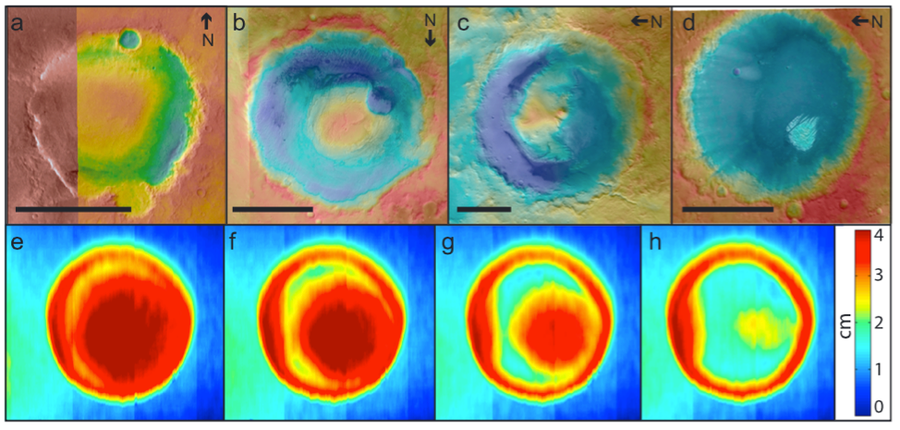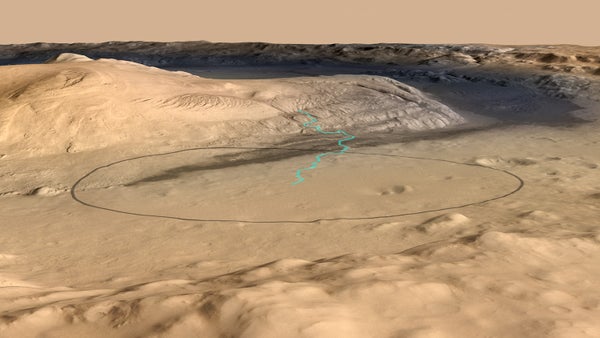Rising from the floor of Gale Crater on Mars, a stack of sedimentary rock called Mount Sharp towers 5.5 kilometers above the ground. The mountain is only a little shorter than North America’s tallest peak, Alaska’s Mount Denali (nearly 6.2 kilometers high). Monstrous mountains on Earth are usually created by colliding plates of the planet’s outer shell or by erupting volcanoes. But Mars does not have this kind of plate activity and its volcanoes have probably not been active for at least 500 million years. So planetary scientists have been stumped as to how Mount Sharp—and dozens of other giant peaks that rise from various Martian craters—formed. It has been an enduring puzzle since NASA’s Viking spacecraft first spotted these mounds in the 1970s.
Now research lends support to the idea that winds in Mars’s thin atmosphere, which can gust up to 95 kilometers per hour, built Mount Sharp over billions of years by carving away surrounding rock that once filled the crater to the brim, like an artist scraping a sculpture from a block of stone. The findings were published on March 31 in the journal Geophysical Research Letters.
Mackenzie Day, a geology graduate student at The University of Texas at Austin and her colleagues attacked this mystery using an old elementary school science project method: They built a miniature crater. Theirs was precise, 30 centimeters wide and four centimeters deep, and loaded with damp sand to represent the sediments that likely once filled the crater. The scientists then placed their small facsimile in a wind tunnel and turned on the fan. The wind first formed a crescent-shaped gash in the damp sand, its ends pointing away from the fan. That gash then widened until it became a ringlike moat, leaving the sand in the center intact. Over time the moat deepened until it reached the crater’s floor, but the high pile of sand in the middle remained—an indication that wind erosion can form what scientists saw on Mars. “That was clear enough,” says Gary Kocurek, Day’s advisor and a geologist at U.T. Austin. “But it’s one thing to have a simple little model in a wind tunnel. We wanted to get a better quantification.” So Day, Kocurek and their colleagues then built a computer model to better picture how airflow interacts with the crater’s rim in a Martian environment.
On supporting science journalism
If you're enjoying this article, consider supporting our award-winning journalism by subscribing. By purchasing a subscription you are helping to ensure the future of impactful stories about the discoveries and ideas shaping our world today.

The top row shows different Martian mounds that are likely in different stages of erosion whereas the bottom row shows the results of the crater model in a wind-tunnel experiment. Warm to cool colors indicate high to low elevation.
Credit: Mackenzie Day
Ralph Milliken, a geologist at Brown University who was not involved in the study, is impressed by the way the team integrated physical models with numerical simulations. “It’s pretty rare to see that sort of thing in the planetary science world,” he says. Although the models cannot disprove another wind-driven theory—that breezes built these mounds up by carrying rock grains to them, rather than carving them out—they do nicely explain certain features that the other theory has yet to account for. For instance, Kristen Bennett, a geology graduate student at Arizona State University in Tempe has found that many Martian mounds are off-center within their craters. “This [model] shows that wind erosion can do that,” she says. Once the central mound has been dug out, the pelting wind will push it toward one side of the crater.
On Earth these gradual effects are often obscured by faster-moving forces, like plate tectonics and volcanism. “Wind is powerful but it's slow,” Day says. “On Mars these craters have been exposed to the surface for three billion years so there's a lot of time to do that work and to get that material out of there in a way that we've never really seen on Earth. So it's a result that speaks to the power of wind in a way that we've never really seen before.”
The mounds also provide an excellent view of Mars’ evolution from a wet habitable world to the dry inhospitable one we see today. The layers of Mount Sharp shift from rocky strata at the bottom, laid down in wet times, to other layers at the top, put down in dry periods. Although a change from a water-driven world to a wind-driven world can be seen in specific places on Earth (the iconic sand dunes of the Sahara Desert, for example, are river deposits reworked by the wind), it occurred globally on Mars. “So that's what we see in these mounds—it's the whole scenario captured,” Kocurek says. In one spot, scientists can study the transformation of an entire planet.
